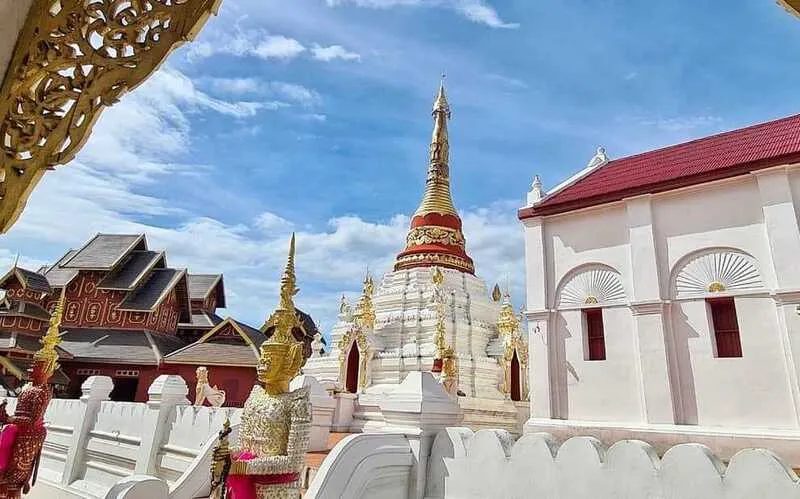Wat Mon Santhan

Rating: 4.2/5 (5 votes)
Lampang attractions
Attractions in Thailand
Operating day: Daily
Operating time: 08.00 - 17.00
Wat Mon Santhan, also known as Wat Mon Pu Yak, is located to the southeast of Lampang city, currently on the east side of the Wang River. The temple sits on a small hill near the city center, not very high. Wat Mon Chamsin, located at No. 15, Phra Bat Subdistrict, Mueang Lampang District, covers an area of 15 rai, 2 ngan, and 8 square wah. It belongs to the Mahanikaya sect of Buddhism. The temple features Burmese-style architecture similar to other Burmese temples throughout the Lanna region and has been continuously restored. The main buildings include a wooden monk’s residence, a viharn (assembly hall), and an ubosot (ordination hall) constructed in traditional brick and mortar.
Wat Mon Pu Yak is believed to have been built in the mid-19th century Buddhist Era, around 1882 CE to the reign of King Rama VI. According to legend, during the time of the Buddha, when he and his arahants traveled eastward to spread Buddhism, they passed through this region. At that time, a giant opposed the spread of Buddhism and tried to drive the Buddha away, following him from the forest of Ban Phra Bat to the area of Mon Chamsin. While the Buddha was residing at Mon Chamsin with his arahants, he foresaw that the giant could be reformed. He allowed the giant to approach and listen to his teachings. Deeply moved, the giant bowed in reverence to the Buddha and requested to stay and practice meditation at Mon Chamsin.
Not long afterward, the giant died near Mon Pu Yak, which is not far from Mon Chamsin. Later, villagers discovered footprints of both the Buddha and the giant near Wat Phra Bat. The local people built a temple over the Buddha’s footprint to elevate it as a sacred site for worship.
According to the “History of Temples Nationwide, Volume 8,” published by the Department of Religious Affairs in 1982, Wat Mon Pu Yak was established on Saturday, September 5, 1899, by Phor Thao Nanta Noi, Phor Thao Nanta Kai, and three other siblings. The temple received its official sacred boundary (Wisungkhamsima) in the same year, covering an area of 14.82 by 14.82 meters. The temple compound includes an ubosot influenced by Western architectural styles, a sermon hall, and a traditional Burmese-style wooden monk’s residence decorated with teak wood carvings, lacquer, and gold leaf. The ceiling is inlaid with mirrors, and there is a chedi crafted by Burmese artisans along with a principal Buddha image lacquered and gilded.
An additional source, a Tai Yai stone inscription dated 1901, records that the temple was built by Mr. Jong Nantakang from Shan State, Myanmar. It commemorated the 30th anniversary of his migration, although today few remember or recognize him.
The area surrounding the temple was once densely covered with tamarind trees. During the rainy season, many plants flourished, but in the dry season, only the tamarind trees remained healthy, earning the area the name “Pa Kham” (Tamarind Forest). Today, it is known as Ban Pa Kham 2 Community in Mueang Lampang District. In the past, traders settled here and used the forest to raise elephants, allowing them to forage naturally, as tamarind leaves and fruit are part of an elephant’s diet and also serve medicinal purposes for them.
Historically, Lampang was a flourishing center of religion and culture. The people were devout Buddhists who observed the precepts and often built temples out of faith and generosity. That is why many temples still stand today. In the Ban Pa Kham area, there are four temples: Wat Mon Pu Yak (Mon Santhan), Wat Mon Chamsin, Wat Chong Kham, and Wat Rom Pho Ngam, with Wat Phra Bat nearby as another important religious site.
The ancient structures of Wat Mon Pu Yak include three main buildings: the wooden kuti, the viharn, and the ubosot, reflecting Burmese architecture mixed with Western influences. The wooden kuti is located west of the viharn, facing south. It is a raised one-story wooden building with layered gabled roofs. Above the entrance is a rectangular mandapa topped with a tiered spire. The building features intricate Burmese wood carvings. Inside is a central hall where a Buddha image is enshrined, and the sides serve as monks’ living quarters. This building is the oldest in the temple.
The ubosot, situated south of the viharn, is a modest-sized brick and mortar structure influenced by Western style, locally known as the “Portuguese-style viharn.” It is decorated with wood carvings, stucco, glass inlays, and gold leaf.
The viharn faces east and is also built from brick and mortar with Western architectural elements such as arched windows and ornate decorations.
Comment
| Keyword (Advance) |
 Facebook Fanpage
Facebook Fanpage

 Category:
Category:  Group:
Group:  Art, Culture and Heritage
Art, Culture and Heritage Historical Sites and Monuments(
Historical Sites and Monuments( Landmarks and Memorials(
Landmarks and Memorials( Art, Craft Centres, Tradition(
Art, Craft Centres, Tradition( Museums(
Museums( Historical Houses and The Ancient City(
Historical Houses and The Ancient City( University
University Other religious and spiritural sites(
Other religious and spiritural sites( Research and Development
Research and Development Royal Project(
Royal Project( Suburban Living
Suburban Living Village, Community(
Village, Community( Local Market(
Local Market( Nature and Wildlife
Nature and Wildlife National Parks and Marine Reserves(
National Parks and Marine Reserves( Mountain (Doi)(
Mountain (Doi)( Dam, Reservoir, Lake(
Dam, Reservoir, Lake( Waterfalls(
Waterfalls( Hot Springs(
Hot Springs( Caves(
Caves( Flower Field(
Flower Field( River, Canal(
River, Canal( Bays and Beaches(
Bays and Beaches( Other natural attractions(
Other natural attractions( Entertainment and Agricultural
Entertainment and Agricultural Animal camps and shows(
Animal camps and shows( Farm, Parks, Gardens and Ecotourism(
Farm, Parks, Gardens and Ecotourism( Outdoor and Adventure Activities(
Outdoor and Adventure Activities( Shopping
Shopping Shopping and Night Market(
Shopping and Night Market( Spas and Wellness
Spas and Wellness Spas and Wellness(
Spas and Wellness(